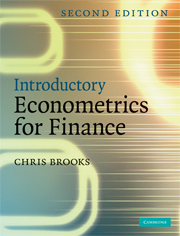Book contents
- Frontmatter
- Contents
- List of figures
- List of tables
- List of boxes
- List of screenshots
- Preface to the second edition
- Acknowledgements
- 1 Introduction
- 2 A brief overview of the classical linear regression model
- 3 Further development and analysis of the classical linear regression model
- 4 Classical linear regression model assumptions and diagnostic tests
- 5 Univariate time series modelling and forecasting
- 6 Multivariate models
- 7 Modelling long-run relationships in finance
- 8 Modelling volatility and correlation
- 9 Switching models
- 10 Panel data
- 11 Limited dependent variable models
- 12 Simulation methods
- 13 Conducting empirical research or doing a project or dissertation in finance
- 14 Recent and future developments in the modelling of financial time series
- Appendix 1 A review of some fundamental mathematical and statistical concepts
- Appendix 2 Tables of statistical distributions
- Appendix 3 Sources of data used in this book
- References
- Index
14 - Recent and future developments in the modelling of financial time series
- Frontmatter
- Contents
- List of figures
- List of tables
- List of boxes
- List of screenshots
- Preface to the second edition
- Acknowledgements
- 1 Introduction
- 2 A brief overview of the classical linear regression model
- 3 Further development and analysis of the classical linear regression model
- 4 Classical linear regression model assumptions and diagnostic tests
- 5 Univariate time series modelling and forecasting
- 6 Multivariate models
- 7 Modelling long-run relationships in finance
- 8 Modelling volatility and correlation
- 9 Switching models
- 10 Panel data
- 11 Limited dependent variable models
- 12 Simulation methods
- 13 Conducting empirical research or doing a project or dissertation in finance
- 14 Recent and future developments in the modelling of financial time series
- Appendix 1 A review of some fundamental mathematical and statistical concepts
- Appendix 2 Tables of statistical distributions
- Appendix 3 Sources of data used in this book
- References
- Index
Summary
Summary of the book
The purpose of this book was to present and explain, at the introductory level, a variety of techniques that are commonly used for the analysis of financial data, including topics that would usually be treated only in a mathematically advanced way. The book commenced with an outline of some stylised characteristics of financial data and described one econometric software package that is widely employed for the financial data exploration. The techniques and models presented included linear models, univariate linear time series approaches, dealing with non-stationary data and long-run modelling, models for volatility and correlation, limited dependent variable approaches, panel data, regime switching models and simulations methodologies. Along the way, examples were presented in each chapter of relevant financial applications from the published literature, and sample instructions or codes for the software package were also given.
What was not covered in the book
Although this textbook was intended to offer as broad a set of analytical techniques as possible, this in part conflicts with the twin objective of maintaining the book at a manageable length with all of the material at the introductory level so that it can be followed by students completely new to the subject on a one- or two-semester course. Consequently, some interesting and arguably relevant topics have been omitted owing to space constraints. These topics are discussed (with no equations and in no particular order!) below.
- Type
- Chapter
- Information
- Introductory Econometrics for Finance , pp. 598 - 606Publisher: Cambridge University PressPrint publication year: 2008



